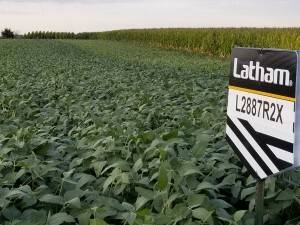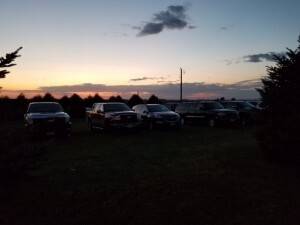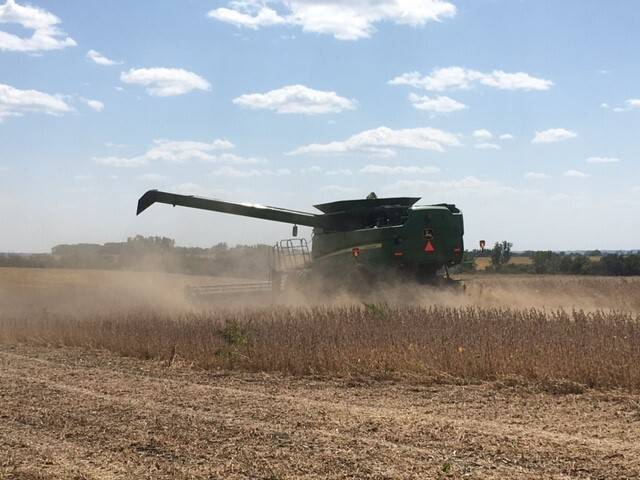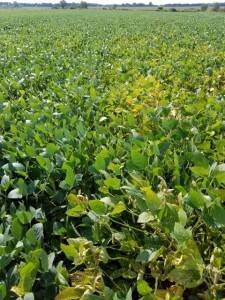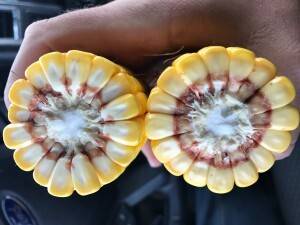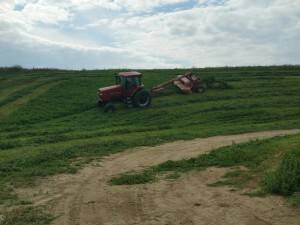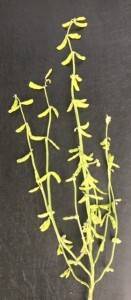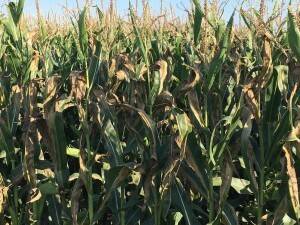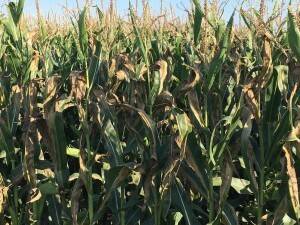From the Field Crop Report: Sept. 6
Northeast Iowa & Southeast Minnesota
Craig Haaland
Found these nice, consistent ears and ear height in this field of Latham LH 5175 VT2 in Clayton County. This looks like a good yielding corn. Farmers are going to start chopping these next few days the way there talking.
Latham® Hi-Tech Soybeans 2084 and L 2228 in this county are podded nicely and filled to the top.
Eastern Iowa
Jerry Broders
Latham L2887 R2X are looking great in Eastern Iowa! If you’re looking for a high yielding soybean with a super defensive package, look no further.
The sun is setting on another field day during the 2017 crop season. With harvest approaching, only a few field days remains. Come see what Latham Hi-Tech Seeds has to offer for 2018 at Alexander on September 15. Tours begin at 9 AM and 1 PM. You can come early and stay for lunch or come for lunch and stay for the afternoon tour. Mike Pearson of Market to Market is our luncheon speaker, so make plans to join us next Friday!
North Central Iowa & South Central Minnesota
Cory Greiman
Although with Sudden Death Syndrome (SDS) infects soybean plants right after germination and emergence, symptoms generally do not appear until mid- to late summer. Future management tactics include: reducing soil compaction; planting fields with a history of SDS towards the end of a planting schedule when soils may be warmer and drier; and testing for the presence of Soybean Cyst Nematodes. Planting tolerant varieties, or avoiding very susceptible varieties, is the most effective way to reduce losses from SDS.
Central Iowa
Bryan Rohe
Soybean harvest has begun in Prairie City, Iowa. These soybeans were planted April 11 and are running around 12.5 moisture.
West North Central Iowa
Bart Peterson
Latham® L2558L was planted May 12 in this SuperStrip plot near Steamboat Rock, Iowa. This photos shows a side-by-side comparison of soybean seed treated only with SoyShield (on right side) and those treated with Soyshield/ILevo (on left side). Notice how much greener the Soyshield/ILevo side is!
Northwest Iowa
Darin Chapman
Look at the kernel depth on this LH 4955 VT2 PRO! This is one of my favorite hybrids for Northwest Iowa, and I’m looking to seeing harvest results.
Western Iowa & Eastern Nebraska
Larry Krapfl
Pretty happy with this second cutting of new seeding Spring 2017. It’s been an extremely dry summer in the Loess Hills of Western Iowa but 455TQ is handling it well.
Southern Wisconsin
Greg Mair
The late-plated soybeans in Wisconsin are finally starting to fill the pods. This plant from a field of L 1845 R2X is one I randomly sampled last week in Watertown, Wisconsin. There are 103 pods on this plant with excellent lateral branching. Wet weather has white mold showing up in places we haven’t seen it before, so this would be a good variety to look at for selecting resistance in 2018.
Eastern North Dakota
Brian McNamee
2017 continues to be a real struggle for growers across my region. We have seen an extensive drought, causing failure of pre-emergence chemicals leading to expansion of resistant weeds into new areas. Then after a seemingly saving amount of rain we observed reduced pollination with poor grain fill. So now what? Well, no we’re seeing disease pressure. Goss’ Wilt is showing up in areas where we have never ever had symptoms before.
The disease went undetected for sometime and spread across the plant very rapidly. We’ll be noting where this disease is present, so we can change hybrid placement in the future. Because this is truly a new event in our area, there will be a bit of a learning as we go. Hopefully, this is the last of our hiccups before harvest!
Northeast South Dakota
James Keltgen
Some of the earlier corn is 30-40% milk line, nearing full maturation. Heavy dew and high humidity is creating disease pressure from rust, Northern Corn Leaf Blight and Goss’s Wilt. Soybeans are really starting to turn yellow as they are nearing maturity. Some areas in the drought will get better than expected yields thanks to some saving rains! Pictured below is John Latham, Myron Keltgen and Phil Long inspecting LH 5245 VT2 PRO. The soybean picture is L0982R2 on the left half and L1438R2 on the right half. L1438R2 showing a little white mold possibly from time of irrigation application. (Brown in center)
Southeast South Dakota
Ramie Coughlin
This field of Latham® 2228R2 near Beresford, South Dakota, was planted at 160,000 in 30-inch rows. It has lots of 4+ pods per node with 3-4 beans in each pod and is filled all the way to the top.
Northern Minnesota
Ken Highness
These pictures were taken last Tuesday in a field of corn near Beltrami, Minn. Samples were taken to NDSU for diagnostics and confirmed Goss’s Wilt. This corn disease was first confirmed in Minnesota 2009, and the first I have seen in my region North of Interstate 94. This disease can be managed by using resistant hybrids, rotating from corn production, using tillage that buries corn residue after harvest, and controlling grassy weeds. Latham has hybrids that are designated as “the boss on Goss,†so be sure to check those out for 2018 planting.
Southern Minnesota
Brandon Wendlandt
L 1787 L are looking great in the late season! Now is a good time to evaluate your weed control program. Maybe Liberty will be a fit. Go ahead and call Latham Hi-Tech Seeds, and I’d be happy to talk with you about your needs.
